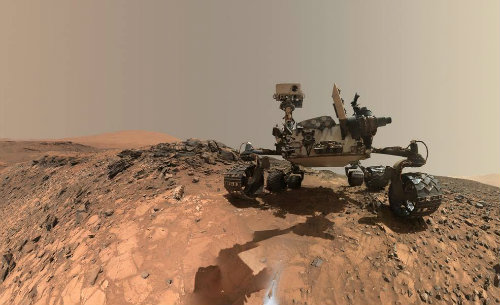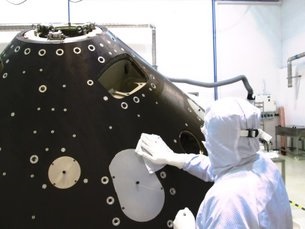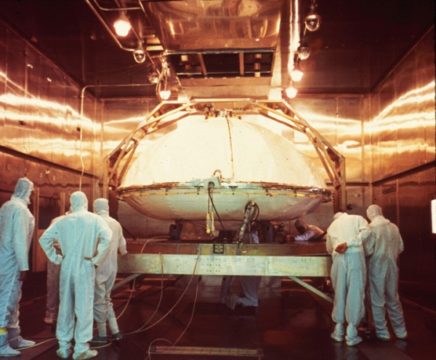A new National Academies study assesses NASA's efforts to protect neighboring worlds from contamination and recommends ways the space agency could do a better job.

NASA / JPL / Caltech / MSSS
It's a tricky dilemma, but one we'll need to deal with as we move on with dedicated solar system exploration. How do we assure that our spacecraft do not inadvertently contaminate Mars, Europa, Enceladus, or Titan — all possible abodes for life?
A just-released study from the National Academies of Sciences, Engineering, and Medicine calls for an overhaul of existing protocols to meet those challenges amid the evolving landscape of solar system exploration. Broadly speaking, "planetary protection" involves preventing not only possible contamination of distant worlds but also the possibility of bringing contaminants back to Earth. Specifically, the report calls for NASA to identify improvements to its existing procedures and to establish protocols for sample-return missions, human exploration of Mars, and the introduction of new players in planetary exploration, namely, private companies like SpaceX.
All of these types of missions might get off the launch pad in the 2030s, if not sooner, and changes in planetary-protection measures will need to keep up with the times.
“NASA has played a pivotal leadership role in developing successful planetary protection policies for more than five decades,” says committee chair Joseph Alexander in a press release. “Soundly framed and executed planetary protection policies will play a critical role in ensuring that space exploration efforts deliver unambiguous answers about the possibility of life elsewhere in the solar system.”
In the U.S., the job of protecting Earth and other worlds falls on NASA's Office of Planetary Protection. Lisa M. Pratt, its current manager, has arguably the best job title in the world: Planetary Protection Officer.

ESA / Airbus Space and Defence
Current policies are a patchwork that vacillates between international protocol versus national implementation. More countries than ever before are getting into the planetary-exploration game, especially when it comes to Mars. The European Space Agency is launching its ExoMars rover during the next launch window in 2020. China likewise plans to send an orbiter, lander, and rover to the Red Planet in two years. Even the United Arab Emirates is assembling a Mars-bound spacecraft.
Most of these nations have signed and ratified the United Nations Outer Space Treaty which has provisions for planetary protection under Article IX, stating that signatories will “conduct exploration . . . so as to avoid harmful contamination . . .” — but what about private companies, such as SpaceX, that plan to go to Mars in the coming decade?
Old Measures for Brave New Worlds
During the mid-1970s, the Viking 1 and 2 landers became the first craft subjected to stringent sanitary measures, as they were "baked" at 232°F (111°C) for 40 hours prior to launch. But Soviet teams tried to land on Mars four times prior to Viking — all unsuccessfully, save for Mars 3, which transmitted for 20 seconds after landing before falling silent. These craft were not sterilized to the same degree.
Terrestrial microbes are hardy: Though an early claim of bacteria found surviving inside Surveyor 3 hardware brought back by Apollo 12 astronauts has been called into question, astronauts have found bacteria surviving in the harsh vacuum of space on the exterior of the International Space Station.

NASA
A package fielded by the Planetary Society on Russia's ill-fated Phobos-Grunt mission would've studied whether tardigrades could've survived the sample-return mission to the Martian moon. But malfunctions stranded the spacecraft in a parking orbit around Earth after launch, and it reentered over the South Pacific Ocean on January 15, 2012.
Currently the most stringent measures are taken during Mars missions, though even these will need to be tightened for future landers and rovers specifically looking for life. For example, Curiosity rover is kept away from some locations on Mars to avoid possible contamination.
SpaceX also recently stirred up a bit of controversy when it launched Elon Musk's Tesla Roadster into a solar orbit on February 6, 2018, on the inaugural flight of the Falcon Heavy rocket. Its orbit crosses those of Earth and Mars, and millions of years from now that unsterilized vehicle might one day crash into either planet.
Meanwhile, NASA's Galileo and Cassini orbiters ended their missions with fiery atmospheric entries into Jupiter and Saturn, respectively, to save any of the gas-giant moons from possible Earth contamination. Juno, now in orbit around Jupiter, will meet the same fate.
The ultimate conundrum is whether it's possible to sterilize the bacteria-filled water bags called humans. Can we safely study precious samples returned from other worlds without compromising them? Planetary protection seeks assure that the alien bacteria we find on distant worlds aren't, in fact, our own.
 4
4









Comments
Bob
July 13, 2018 at 10:50 am
David...
Great article and I enjoyed the video. Thanks for sharing.
Bob
"bacteria-filled water bag"
You must be logged in to post a comment.
Peter Wilson
July 13, 2018 at 12:44 pm
Anyone claiming to discover life on another planet is going to have to subject their organism(s) to gene-sequencing, to persuade the skeptics. If we cannot tell a Martian microbe from an Earthly "contaminant" by such IDing, then the entire gene-sequencing industry and libraries of terrestrial gene-sequences do not exist.
You must be logged in to post a comment.
Gordon
July 14, 2018 at 10:41 pm
People are going to contaminate Mars soon. Scientists wanting a private lab isn’t going to matter when the future mineral rights are in the trillions of dollars. It would be best to set a “no sooner than” date.
You must be logged in to post a comment.
Ransom
July 18, 2018 at 5:09 pm
I think it is likely we will find evidence of life one day on the moon or planets in our solar system, and it will have originated from Earth. With all the asteroids that have impacted Earth over the past billions of years, some living organisms will have been blasted off and carried to other bodies in our solar system. If we investigate the moon carefully enough, we'll probably find something there. I'm skeptical that we'll ever find alien life because we do not know of any other place with the extremely precise conditions required for life to thrive.
You must be logged in to post a comment.
You must be logged in to post a comment.